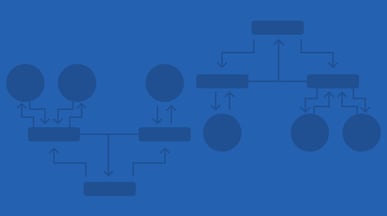Share this
The Ultimate Guide To Creating a Successful Marketing Workflow
by Erin Esterberg on January 25, 2022 4:03:00 AM EST
We can’t deny that in today’s business environment, marketing is growing more complex than ever: marketing teams are getting bigger and must handle even more activities from email, social media, public relations, advertising, and more.
Yet, we can only expect marketing to grow even more complex and challenging in 2022 and in the years to come.
Ensuring your marketing team stays productive, organized, and effective can be very challenging. The key to success is to create a marketing workflow capable of handling the details of every campaign and marketing project, and potentially consider using project management software to assist.
In this ultimate guide to creating a marketing workflow, we’ll discuss all you need to know about creating an effective marketing workflow for your marketing team.
By the end of this guide, you’ll have learned about:
-
What is a workflow?
-
What is a marketing workflow?
-
The benefits of having a comprehensive marketing workflow
-
A step-by-step guide on creating an effective marketing workflow
-
How to analyze and optimize your marketing workflow to improve its efficiency
And more!
Marketing Workflow: The Concept
First, what is a workflow? 
We can define a workflow as a set of tasks or actions, typically sequential, that can help us achieve a specific objective when accomplished.
All businesses, organizations, and even professional individuals always deal with (at least one) workflow/s. For a coffee shop, for example, preparing its signature brew is a workflow.
In practice, however, a typical organization can involve multiple intricately linked workflows, and each department or division within the organization can have its workflows.
What is a Marketing Workflow?
A marketing workflow is a workflow within a marketing department: a series of steps or tasks that tell the members/stakeholders of the marketing team what to do when to do it, and how to do it to complete a specific marketing objective while meeting a set of requirements to stay compliant with a particular standard.
As we know, however, there can be so many marketing objectives in a single organization, from high-level objectives to granular goals.
For example, onboarding a new marketing client in a marketing agency can be considered a workflow. On the other hand, developing marketing collateral (i.e., a poster) can also be considered a marketing workflow.
Mapping a Marketing Workflow
 A workflow always existed as a concept but isn’t always visualized and documented.
A workflow always existed as a concept but isn’t always visualized and documented.
All workflows, including marketing workflows, can be visualized in a workflow diagram, often within work management or project management software. A workflow diagram will outline (in detail) the sequence of steps your team will make as they complete a particular marketing task.
By visualizing and documenting a workflow, you can get the following benefits:
1. Standardizing how the workflow should be executed
Having an accurate workflow diagram for the marketing workflow and making it available for your stakeholders can ensure everyone involved in the workflow can understand precisely how the workflows get executed.
By standardizing marketing workflows, you can minimize risks of errors while at the same time will also boost the transparency of the workflow and accountability of everyone involved in the workflow.
More accountability, in turn, will result in you improving the marketing team’s collaboration and productivity.
2. Improving the quality and consistency of deliverables
Again, a properly documented and optimized marketing workflow diagram will provide clear instructions and guidance for the marketing team to execute the workflow in the most efficient manner possible.
By having a standardized, optimized map for executing the workflow, your marketing team will be more encouraged to collaborate to deliver the highest-quality deliverables possible. The higher-ups and the clients will be more satisfied with the results of the marketing workflow.
3. Improving the profitability of each workflow
An optimized marketing workflow will require fewer resources and less time to execute. Meaning, your marketing team can do more in less time, improving the ROI of each marketing project and ultimately elevating your business’s profitability.
4. Ensuing workflows are executed as efficiently as possible
Having a well-documented marketing workflow can allow organizations to accurately analyze the performance of each workflow and identify its inefficiencies and bottlenecks. Ultimately this will enable businesses to optimize their marketing workflow to ensure it’s as efficient as possible.
Also, when a workflow is well-documented, it’s easier to adjust and optimize it with new strategies and techniques. Meaning, a marketing workflow diagram can provide you with a predictable method to constantly optimize and improve the workflow’s efficiency.
Marketing Workflow Management: Optimizing Your Marketing Workflows
 Workflow management is optimizing a business workflow to ensure the workflow is executed as efficiently as possible.
Workflow management is optimizing a business workflow to ensure the workflow is executed as efficiently as possible.
Each workflow is unique and requires unique optimization approaches to ensure efficiency. However, in practice, a workflow management process always consists of three key phases:
-
Workflow mapping: visualizing the workflow in a workflow diagram and documenting all the workflow's relevant information.
-
Workflow analysis: analyzing the workflow diagram and the relevant data to identify bottlenecks and inefficiencies. This analysis process aims to develop an optimization plan to improve the workflow (if possible).
-
Workflow optimization: implement the changes planned according to the results of the workflow analysis phase. Monitoring the changes implemented to ensure they've provided positive impacts. If the workflow is not yet optimal, further rounds of analysis and optimization may be needed.
Below, we will discuss how to perform these three phases of workflow management on your marketing workflows to ensure they are as efficient as possible.
Step-By-Step Guide To Marketing Workflow Management
Step 1: Picking and prioritizing which marketing workflow to optimize
This won't be an issue if your organization only has one marketing workflow within your work management or project management software, and you can skip this step.
However, suppose you have multiple marketing workflows. In this case, we should keep in mind that we have finite resources and time, and we should prioritize which workflow to manage and optimize first.
In general, we can use three basic approaches in choosing and prioritizing between different workflows:
-
Strategic approach: choosing the workflow most crucial to your overall marketing efforts. That is, workflows that, when optimized, can significantly impact your marketing results.
-
Reactive approach: Mapping and optimizing workflows that are flawed, or inefficient. We manage and optimize these workflows to fix the issue ASAP and minimize its negative impacts.
-
Customer-centric approach: picking and prioritizing workflows that impact your client’s experience. For example, optimized workflows can significantly shorten your client’s waiting time.
Step 2: Data Gathering
Once you’ve identified which workflow you’d like to map and optimize, the next step is to gather as much information as you can about this workflow.
You can use several approaches in this data gathering process:
-
Observation: you can perform manual observations or automated (with technology) observations of how the marketing workflow is currently getting executed.
-
Survey/interview: interviewing stakeholders and team members involved in the workflow execution. Ask them as many relevant questions as you can and gather feedback about how they think the marketing workflow is currently executed and how they’d improve this workflow.
-
Analytics: you can use various analytics tools to monitor the workflow’s current performance.
The more information you get about the workflow, the more accurate you map it. You should at least gather the following data:
-
Start and endpoints of the workflow
-
The list of all tasks/actions in the workflow
-
Establishing roles and responsibilities of everyone involved in the workflow
-
Establish timelines for each task in the workflow
Step 3: Mapping your marketing workflow
Now that you have picked a marketing workflow to optimize, the next step is to map this workflow into a workflow diagram.
You can use various techniques and methods to map your workflow, but the most common ones are:
1. Flowchart
Most of us are already familiar with the concept of flowcharts.
Flowcharting is creating a workflow diagram using shapes and symbols (rectangles, circles, arrows, etc.) to visually represent the steps and decisions needed to complete the marketing workflow.
2. Swimlane diagram
A swimlane diagram describes and differentiates roles and responsibilities in a marketing workflow. This is also why it’s often called a “cross-functional” diagram.
A swimlane diagram is very similar to a basic flowchart in many ways. Still, the main difference is how the diagram is divided horizontally into different lanes, just like in a competitive swimming pool. Each lane represents one role/responsibility in the workflow.
3: Dataflow Diagram
.png?width=230&name=Appaserver_Data_Flow_Diagram_(blue).png) A data flow diagram (DFD) is similar to a flowchart in many ways but emphasizes the movement of data that flows through the marketing workflow.
A data flow diagram (DFD) is similar to a flowchart in many ways but emphasizes the movement of data that flows through the marketing workflow.
Marketing Workflow Mapping: Best Practices
 In most cases, you can use the standard ANSI flowchart to map most marketing workflows unless you’d want to emphasize some elements of the workflow.
In most cases, you can use the standard ANSI flowchart to map most marketing workflows unless you’d want to emphasize some elements of the workflow.
While the actual workflow mapping can vary depending on the workflow itself and other factors, here are some principles and best practices you can follow to map the marketing workflow accurately:
-
In most cases, it’s better to map the workflow backward from output to input. This is true for most marketing workflows, except on unique workflows requiring mapping them from input to output.
-
Before mapping the workflow, make sure to identify the workflow's purpose and its objectives. Always focus on the big picture when mapping the workflow.
-
Begin by defining the scope and limitation of the marketing workflow
-
Accurately define the start and end points of the workflow before you start the mapping process
-
In any hand-offs, aim to reduce inefficiencies
-
Accurately list and identify all steps and tasks of the workflow. Involve all stakeholders involved in the workflow so you’ll get a clearer picture of how each step and task should be executed.
-
Aim to be as accurate as possible. Since the purpose here is to optimize the workflow, then you should create an as-is diagram instead of a to-do diagram (diagram of how the workflow is executed at the moment.)
-
When mapping tasks, steps, and sub-processes, keep them as simple as possible
-
Define all KPIs and metrics related to the workflow: time, resources usage, equipment usage, volume, rates/cost, and other relevant values. Test and evaluate the marketing workflow with these accepted metrics.
Don’t overthink how you should map the workflow. You can start with a pen and paper, although if possible, you should use technology to help you in both accuracy and speed. A workflow management software with a built-in business process map builder can significantly help in the whole process.
Step 4: Analyzing the marketing workflow
Once you’ve correctly mapped the workflow diagram, we can perform a thorough analysis to evaluate the efficiency of the marketing workflow.
The purpose of this step is to identify inefficiencies and bottlenecks in the workflow so you can develop an optimization plan identifying how the workflow should be improved to ensure its efficiency.
How you should analyze the workflow will vary depending on the workflow itself and other factors, but in general, you should focus on these critical areas:
-
Categorize and prioritize tasks based on their importance and contribution to the workflow. You can do this in various ways, for example, categorizing the tasks into four ‘tiers’: very important, important, nice to have, and redundant.
-
Look for any inefficiencies, redundancies, and bottlenecks that may slow down the workflow.
-
Assess whether the tasks and steps of the workflow are aligned well with your overall marketing objectives and the workflow’s specific objectives.
-
Look for automation opportunities. If it’s feasible and cost-effective enough to automate a task or the whole workflow, then you should go for it.
In this step, you should also ask the following key questions:
-
Are there tasks and steps that can be simplified or eliminated?
-
What’s the current success/failure rate of the workflow?
-
How long does it currently take to complete the workflow on average?
-
Where do bottlenecks occur in the workflow?
-
Are any steps confusing? Can all stakeholders access the required information to execute the workflow and make the necessary decisions?
-
Is it possible and feasible to automate tasks or the whole workflow?
Based on this analysis, identify possible areas that can be improved and develop a comprehensive optimization plan for the workflow. This plan should describe in detail how you will implement changes to optimize the workflow, which will be the focus for the next step.
Step 5: Optimizing the marketing workflow
Based on the optimization plan developed due to the analysis process, you should implement the changes to the marketing workflow and update the workflow diagram as needed.
If there are multiple changes planned, implement them one by one to review whether each of these planned changes makes positive improvements to the workflow.
Be open to the possibility that your analysis results may be wrong: sometimes, when changes get implemented, they may not cause any improvement at all, and in some cases, they can end up making the workflow more inefficient than before.
You may want to collect feedback from the stakeholders of the workflow in this step so they can help test the workflow and review the changes. Let them voice their concerns; they may offer valuable insights into how the workflow should be optimized further.
Sometimes, as mentioned, optimizations won’t go according to plan, and you may need to perform another round of analysis and optimization. It’s crucial to approach workflow optimization not as a one-off thing but instead as a continuous process.
We should embrace the fact that there will always be room for improvements: even if the marketing workflow is already optimal, new technologies and techniques may be introduced in the near future, and your competitors may have more efficient workflows, which will demand another round of optimization.
Once you’ve decided that the workflow is already as efficient as possible, you can also implement automation to the workflow as you see fit.
Wrapping Up
There you have it! Above, we’ve discussed everything you need to know about managing and optimizing your marketing workflows.
With this guide, you are now ready to analyze and optimize your marketing workflows to ensure they are as efficient as possible so that you can achieve your marketing objectives in less time and with fewer resources.
When workflows are efficient and streamlined, you can also improve your marketing team’s morale, lowering your business’s turnover rate and enhancing productivity.
Share this
- Project Management (40)
- Online Proofing (28)
- Featured (27)
- Educational (25)
- New Release (25)
- Work Management (25)
- Business Workflow (23)
- Workflow Management (23)
- Marketing management (22)
- BPM Software (21)
- Business Automation (20)
- Marketing Workflow (20)
- Newsletter (19)
- Workflow Automation (17)
- Marketing Automation (14)
- enterprise project management (10)
- BPM (8)
- business process workflow (8)
- Task Management (7)
- Aproove news (6)
- Digital Asset Management (6)
- News (6)
- insurance work management (6)
- business process automation (5)
- insurance marketing (5)
- team (5)
- Industry News (4)
- marketing process (4)
- Compliance (3)
- Retail Marketing (3)
- brands (3)
- enterprise workflow management (3)
- printing workflow (3)
- AI (2)
- Document Management Automation (2)
- IT Project Management (2)
- Marketing Agency (2)
- Product Development (2)
- creative workflow (2)
- print (2)
- workflow optimization (2)
- Case Studies (1)
- Case Study (1)
- DAM Software (1)
- Document Workflow Automation (1)
- HIPPA (1)
- Healthcare (1)
- ISO (1)
- Insider (1)
- Resource Management (1)
- SOC2 (1)
- SaaS (1)
- banking (1)
- marketing teams (1)
- pharma (1)
- security (1)
- workflow diagram (1)
- workflow process mapping (1)
- workflow software (1)
- April 2025 (8)
- March 2025 (11)
- February 2025 (10)
- January 2025 (10)
- December 2024 (9)
- November 2024 (10)
- October 2024 (5)
- September 2024 (8)
- August 2024 (10)
- July 2024 (9)
- June 2024 (11)
- May 2024 (6)
- April 2024 (7)
- March 2024 (7)
- February 2024 (6)
- January 2024 (4)
- December 2023 (3)
- November 2023 (7)
- October 2023 (7)
- September 2023 (3)
- August 2023 (5)
- July 2023 (3)
- June 2023 (1)
- May 2023 (1)
- April 2023 (1)
- February 2023 (2)
- September 2022 (3)
- August 2022 (1)
- July 2022 (1)
- May 2022 (1)
- March 2022 (3)
- February 2022 (3)
- January 2022 (3)
- November 2021 (2)
- October 2021 (2)
- September 2021 (1)
- August 2021 (4)
- July 2021 (4)
- June 2021 (2)
- May 2021 (3)
- April 2021 (1)
- February 2021 (1)
- November 2020 (1)
- October 2020 (2)
- July 2020 (4)
- June 2020 (2)
- May 2020 (2)
No Comments Yet
Let us know what you think